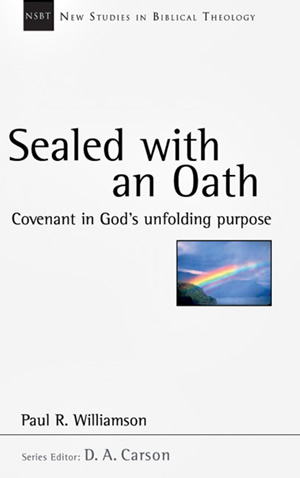
Sealed with an Oath
Description : If the reader plans to study issues related to dispensationalism and biblical covenants, he will want to consult this book. It is a treasure store of exegetical work on a broad range of biblical subjects and passages. It is a heavy, but worthwhile, book. There are 527 footnotes in 208 pages of text. The Bibliography is twenty-five pages, and the Index of Scripture references is thirteen pages, with three columns per page. In short, Williamson has done his homework.
This is a book about biblical theology. Williamson states, “Biblical theology is arguably best thought of as a holistic enterprise tracing unfolding theological trajectories throughout Scripture and exploring no biblical concept, theme or book in isolation from the whole. Rather, each concept, theme or book is considered ultimately in terms of how it contributes to and advances the Bible’s meta-narrative, typically understood in terms of a salvation history that progresses towards and culminates in Jesus Christ” (17).
In this volume the author traces the trajectory of Old Testament covenants from the covenant with Noah through those with Abraham, Israel at Sinai, David, and the New Covenant in Jeremiah 31 and other places. He traces them relative to the preceding ones to their fulfillment in Christ and ultimately to Christ in the eternal kingdom.
Williamson does not directly state if he is reformed in his theology or if he is a dispensationalist. Hints in a few footnotes indicate that he may be reformed. He devotes four pages in two chapters (19, 30, 52–55), however, to deny the existence of the reformed suppositions of a covenant of works and a covenant of grace. He claims they have no basis in Scripture, and he is correct in this assertion. Williamson also anticipates a literal return of Christ and his literal reign on David’s throne. Whether or not he is a dispensationalist, his theology, developed rigorously and thoroughly from Scripture, is certainly compatible with biblical dispensationalism.
Chapter one is introductory and deals with “Biblical Theology and the Covenant Concept.” Chapter two, “Covenant and God’s Universal Purpose,” discusses the nature of a covenant in Scripture. Chapters three through eight deal with God’s covenants with Noah, the patriarchs, Israel, David, and the New Covenant as the prophets described it, as inaugurated in Christ, and as consummated in the eschatological kingdom. The author shows the relationship between God’s covenant with Noah and the covenant with Abraham and the patriarchs. He then explains the biblical development of the succeeding covenants and how the preceding ones relate to the succeeding ones.
The first strength of the book is the clarity with which Williamson puts the scriptural covenants in perspective. He describes God’s revelation as an arc, with each covenant taking revelation closer to its culmination in Christ and his kingdom.
The second strength of the work is the detailed exegesis of many passages. His treatment of each of the covenant passages (Gen 6, 12, 15, 22, 26, 28; Exod 19, 20; 2 Sam 7; Jer 31; Heb 8–10) is outstanding. There is great commen¬tary on many other passages like Isaiah 53, Romans 3, and others too numerous to mention. One may not agree with all of his conclusions, but one should respect, appreciate, use, and profit from the exegetical work that produces those conclusions. The dispensational reader will find himself agreeing with most of his conclusions, because they are grounded in Scripture!
Not everyone will want this book, and not everyone would profit from it. Anyone engaging in serious biblical and theological study, preparation, and education, however, will want this volume. The reader will be stimulated by it and receive a blessing from it.


